FORD CONTOUR 1999 2.G Owners Manual
Manufacturer: FORD, Model Year: 1999, Model line: CONTOUR, Model: FORD CONTOUR 1999 2.GPages: 244, PDF Size: 2.26 MB
Page 91 of 244
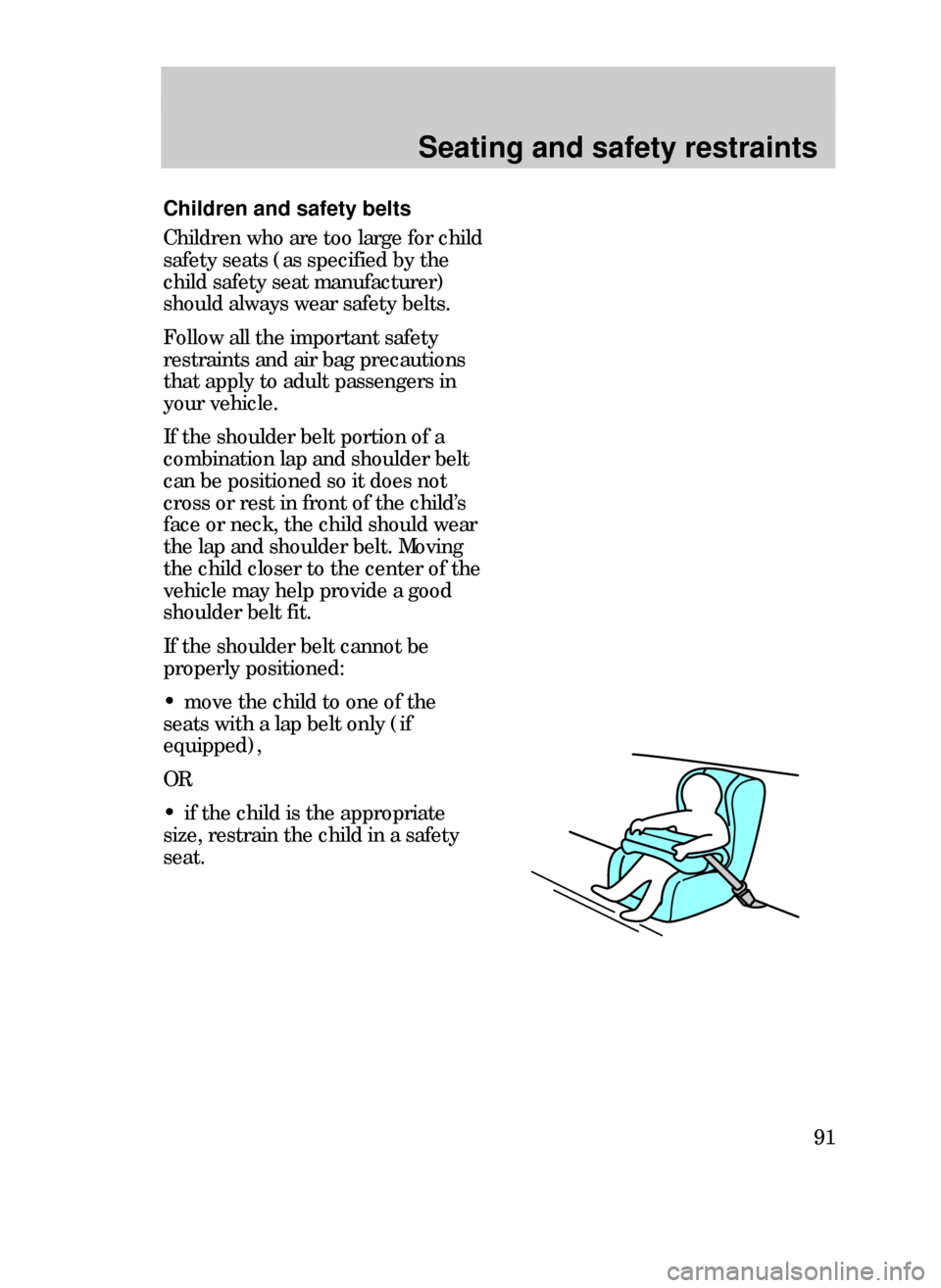
Seating and safety restraints
91
Children and safety belts
Children who are too large for child
safety seats (as specified by the
child safety seat manufacturer)
should always wear safety belts.
Follow all the important safety
restraints and air bag precautions
that apply to adult passengers in
your vehicle.
If the shoulder belt portion of a
combination lap and shoulder belt
can be positioned so it does not
cross or rest in front of the childÕs
face or neck, the child should wear
the lap and shoulder belt. Moving
the child closer to the center of the
vehicle may help provide a good
shoulder belt fit.
If the shoulder belt cannot be
properly positioned:
¥ move the child to one of the
seats with a lap belt only (if
equipped),
OR
¥ if the child is the appropriate
size, restrain the child in a safety
seat.
14CSSen 3/25/99 1:59 PM Page 91
Page 92 of 244
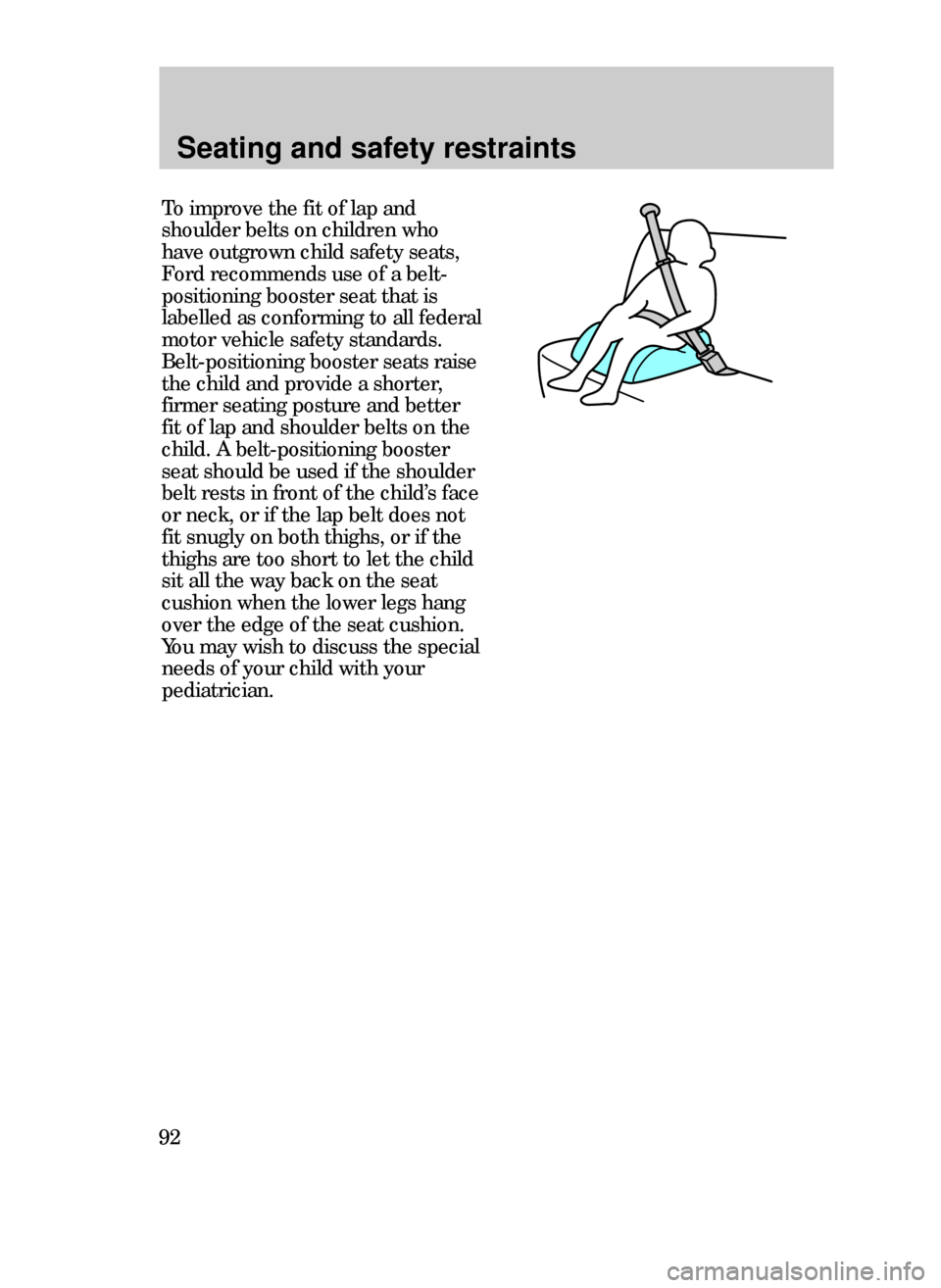
Seating and safety restraints
92
To improve the fit of lap and
shoulder belts on children who
have outgrown child safety seats,
Ford recommends use of a belt-
positioning booster seat that is
labelled as conforming to all federal
motor vehicle safety standards.
Belt-positioning booster seats raise
the child and provide a shorter,
firmer seating posture and better
fit of lap and shoulder belts on the
child. A belt-positioning booster
seat should be used if the shoulder
belt rests in front of the childÕs face
or neck, or if the lap belt does not
fit snugly on both thighs, or if the
thighs are too short to let the child
sit all the way back on the seat
cushion when the lower legs hang
over the edge of the seat cushion.
You may wish to discuss the special
needs of your child with your
pediatrician.
14CSSen 3/25/99 1:59 PM Page 92
Page 93 of 244
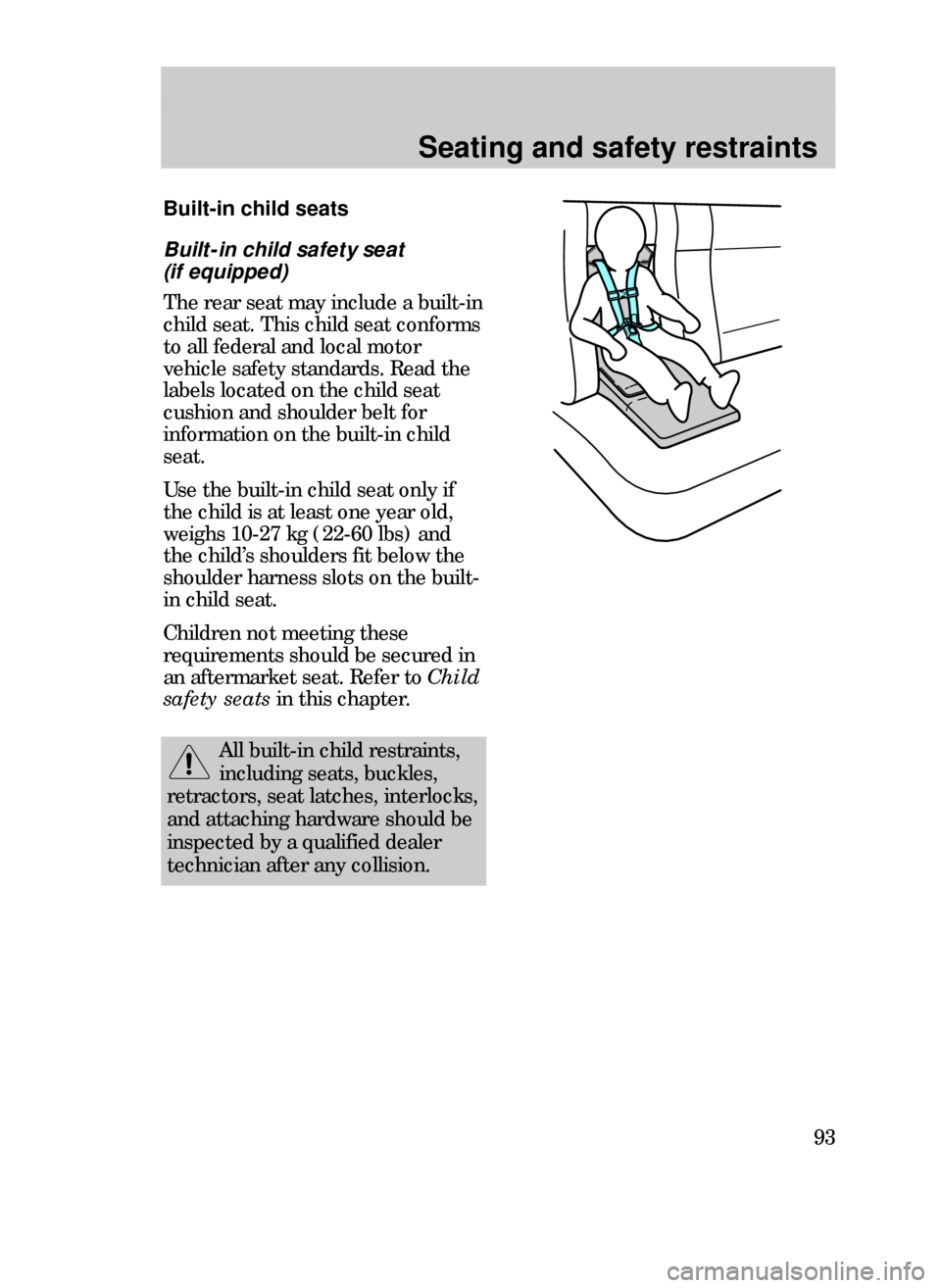
Seating and safety restraints
93
Built-in child safety seat
(if equipped)
The rear seat may include a built-in
child seat. This child seat conforms
to all federal and local motor
vehicle safety standards. Read the
labels located on the child seat
cushion and shoulder belt for
information on the built-in child
seat.
Use the built-in child seat only if
the child is at least one year old,
weighs 10-27 kg (22-60 lbs) and
the childÕs shoulders fit below the
shoulder harness slots on the built-
in child seat.
Children not meeting these
requirements should be secured in
an aftermarket seat. Refer to Child
safety seatsin this chapter.
Built-in child seats
All built-in child restraints,
including seats, buckles,
retractors, seat latches, interlocks,
and attaching hardware should be
inspected by a qualified dealer
technician after any collision.
14CSSen 3/25/99 1:59 PM Page 93
Page 94 of 244
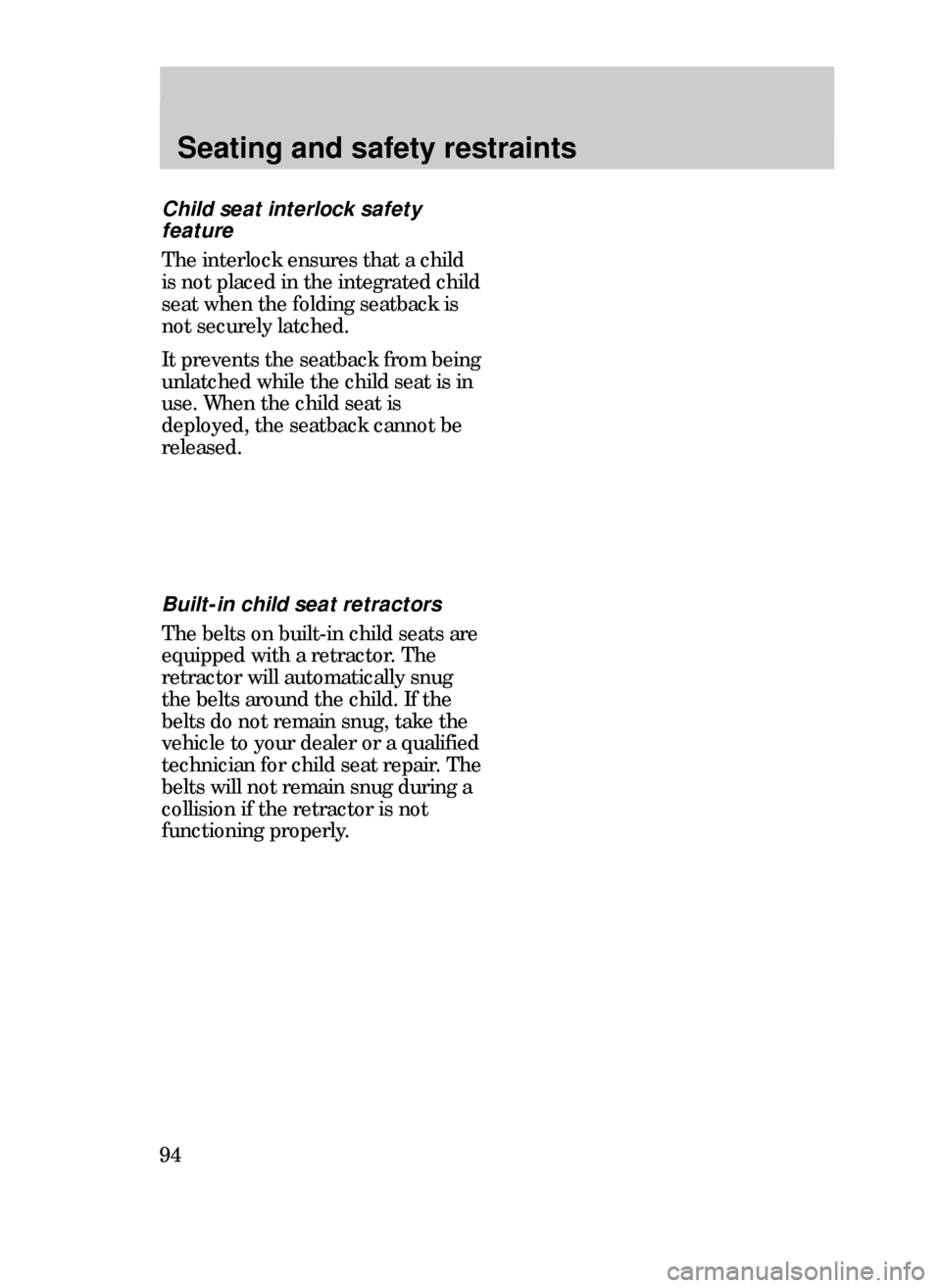
Seating and safety restraints
94
Child seat interlock safety
feature
The interlock ensures that a child
is not placed in the integrated child
seat when the folding seatback is
not securely latched.
It prevents the seatback from being
unlatched while the child seat is in
use. When the child seat is
deployed, the seatback cannot be
released.
Built-in child seat retractors
The belts on built-in child seats are
equipped with a retractor. The
retractor will automatically snug
the belts around the child. If the
belts do not remain snug, take the
vehicle to your dealer or a qualified
technician for child seat repair. The
belts will not remain snug during a
collision if the retractor is not
functioning properly.
14CSSen 3/25/99 1:59 PM Page 94
Page 95 of 244
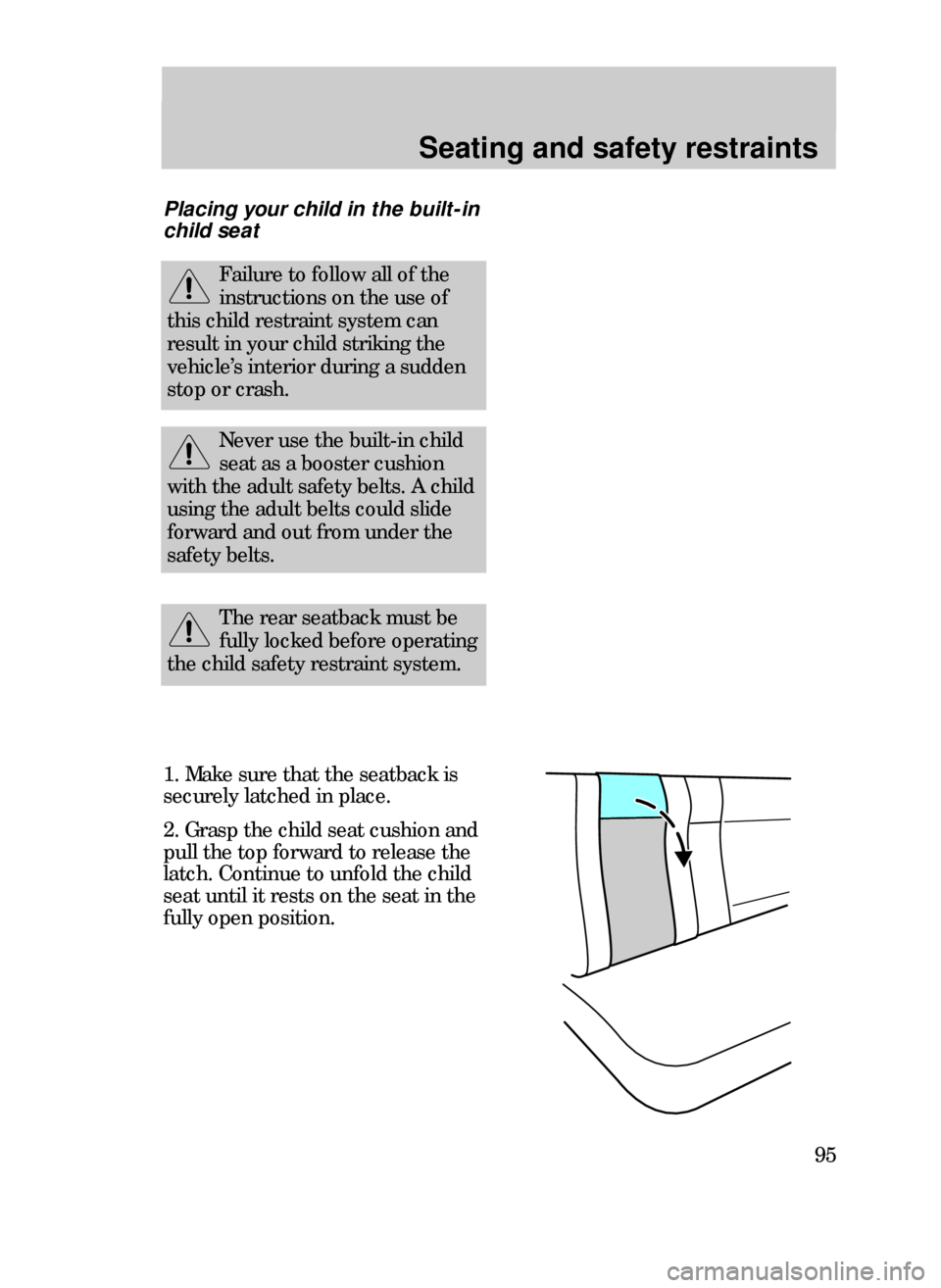
Seating and safety restraints
95
1. Make sure that the seatback is
securely latched in place.
2. Grasp the child seat cushion and
pull the top forward to release the
latch. Continue to unfold the child
seat until it rests on the seat in the
fully open position.
Placing your child in the built-in
child seat
Failure to follow all of the
instructions on the use of
this child restraint system can
result in your child striking the
vehicleÕs interior during a sudden
stop or crash.
Never use the built-in child
seat as a booster cushion
with the adult safety belts. A child
using the adult belts could slide
forward and out from under the
safety belts.
The rear seatback must be
fully locked before operating
the child safety restraint system.
14CSSen 3/25/99 1:59 PM Page 95
Page 96 of 244
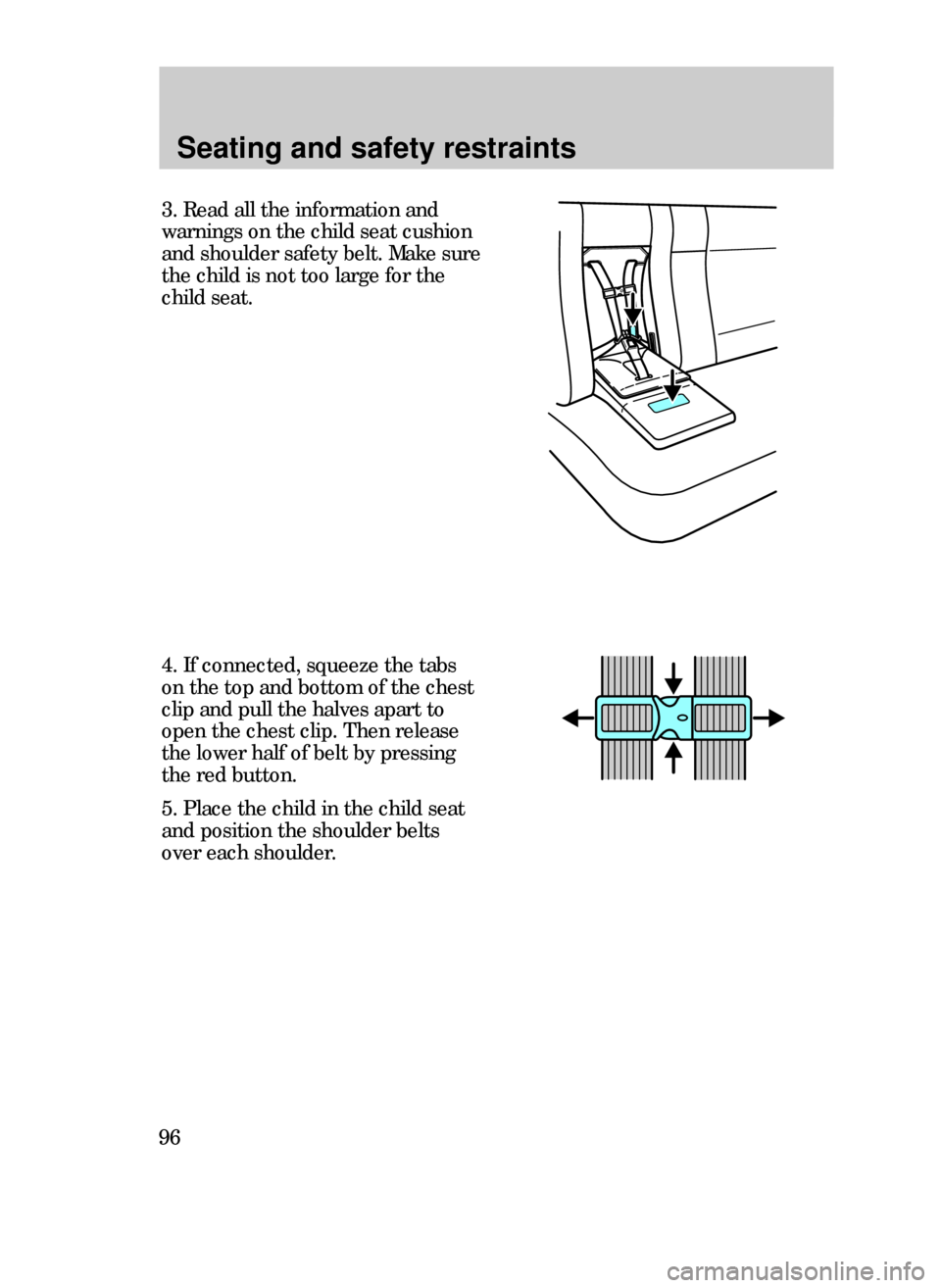
Seating and safety restraints
96
4. If connected, squeeze the tabs
on the top and bottom of the chest
clip and pull the halves apart to
open the chest clip. Then release
the lower half of belt by pressing
the red button.
5. Place the child in the child seat
and position the shoulder belts
over each shoulder.
3. Read all the information and
warnings on the child seat cushion
and shoulder safety belt. Make sure
the child is not too large for the
child seat.
14CSSen 3/25/99 1:59 PM Page 96
Page 97 of 244
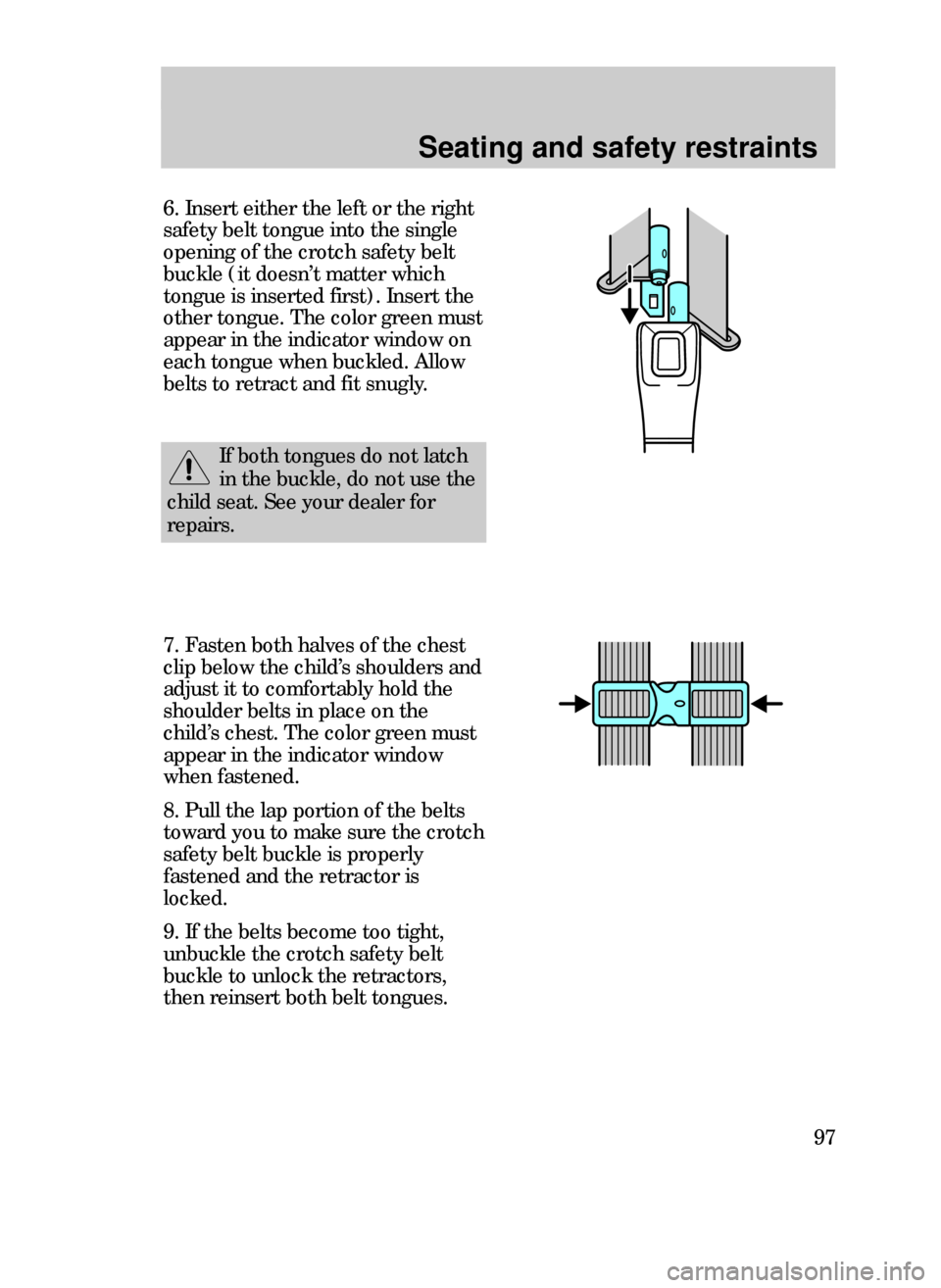
Seating and safety restraints
97
7. Fasten both halves of the chest
clip below the childÕs shoulders and
adjust it to comfortably hold the
shoulder belts in place on the
childÕs chest. The color green must
appear in the indicator window
when fastened.
8. Pull the lap portion of the belts
toward you to make sure the crotch
safety belt buckle is properly
fastened and the retractor is
locked.
9. If the belts become too tight,
unbuckle the crotch safety belt
buckle to unlock the retractors,
then reinsert both belt tongues.
If both tongues do not latch
in the buckle, do not use the
child seat. See your dealer for
repairs.
6. Insert either the left or the right
safety belt tongue into the single
opening of the crotch safety belt
buckle (it doesnÕt matter which
tongue is inserted first). Insert the
other tongue. The color green must
appear in the indicator window on
each tongue when buckled. Allow
belts to retract and fit snugly.
14CSSen 3/25/99 1:59 PM Page 97
Page 98 of 244
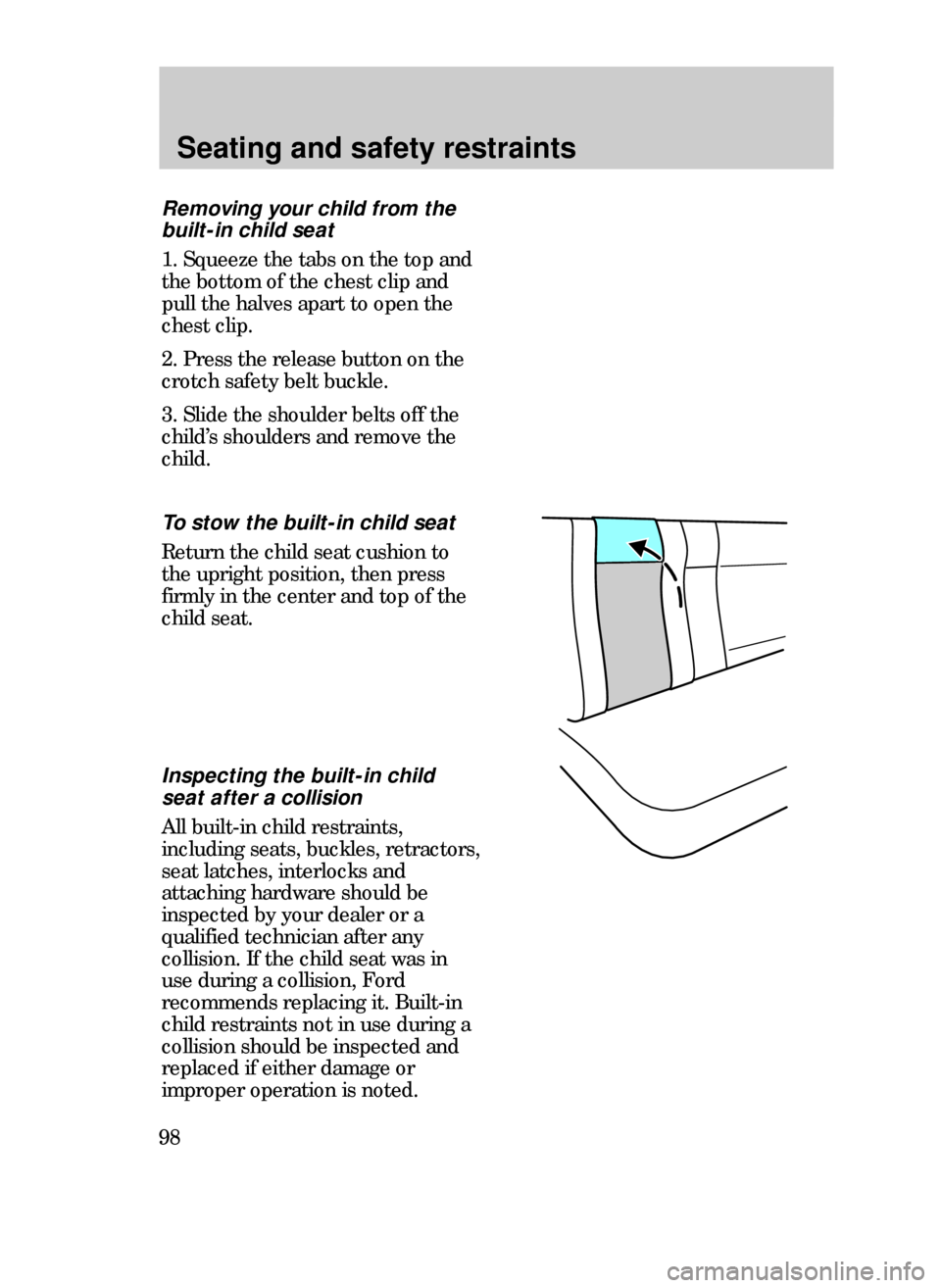
Seating and safety restraints
98
To stow the built-in child seat
Return the child seat cushion to
the upright position, then press
firmly in the center and top of the
child seat.
Removing your child from the
built-in child seat
1. Squeeze the tabs on the top and
the bottom of the chest clip and
pull the halves apart to open the
chest clip.
2. Press the release button on the
crotch safety belt buckle.
3. Slide the shoulder belts off the
childÕs shoulders and remove the
child.
Inspecting the built-in child
seat after a collision
All built-in child restraints,
including seats, buckles, retractors,
seat latches, interlocks and
attaching hardware should be
inspected by your dealer or a
qualified technician after any
collision. If the child seat was in
use during a collision, Ford
recommends replacing it. Built-in
child restraints not in use during a
collision should be inspected and
replaced if either damage or
improper operation is noted.
14CSSen 3/25/99 1:59 PM Page 98
Page 99 of 244

Seating and safety restraints
99
Carefully follow all of the
manufacturerÕs instructions
included with the safety seat you
put in your vehicle. If you do not
install and use the safety seat
properly, the child may be injured
in a sudden stop or collision.
Ford recommends the use of a
child safety seat having a top tether
strap. Install the child safety seat in
a seating position which is capable
of providing a tether anchorage.
For more information on top tether
straps see Attaching safety seats
with tether strapsin this chapter.
When installing a child safety seat:
¥ Use the correct safety belt
buckle for that seating postion.
¥ Make sure the tongue is securely
fastened in the buckle.
¥ Keep the buckle release button
pointing up and away from the
safety seat, with the tongue
between the child seat and the
release button, to prevent
accidental unbuckling.
¥ Put the safety belt in the
automatic locking mode. Refer to
Using automatic locking modein
this chapter.
Child safety seats
14CSSen 3/25/99 1:59 PM Page 99
Page 100 of 244
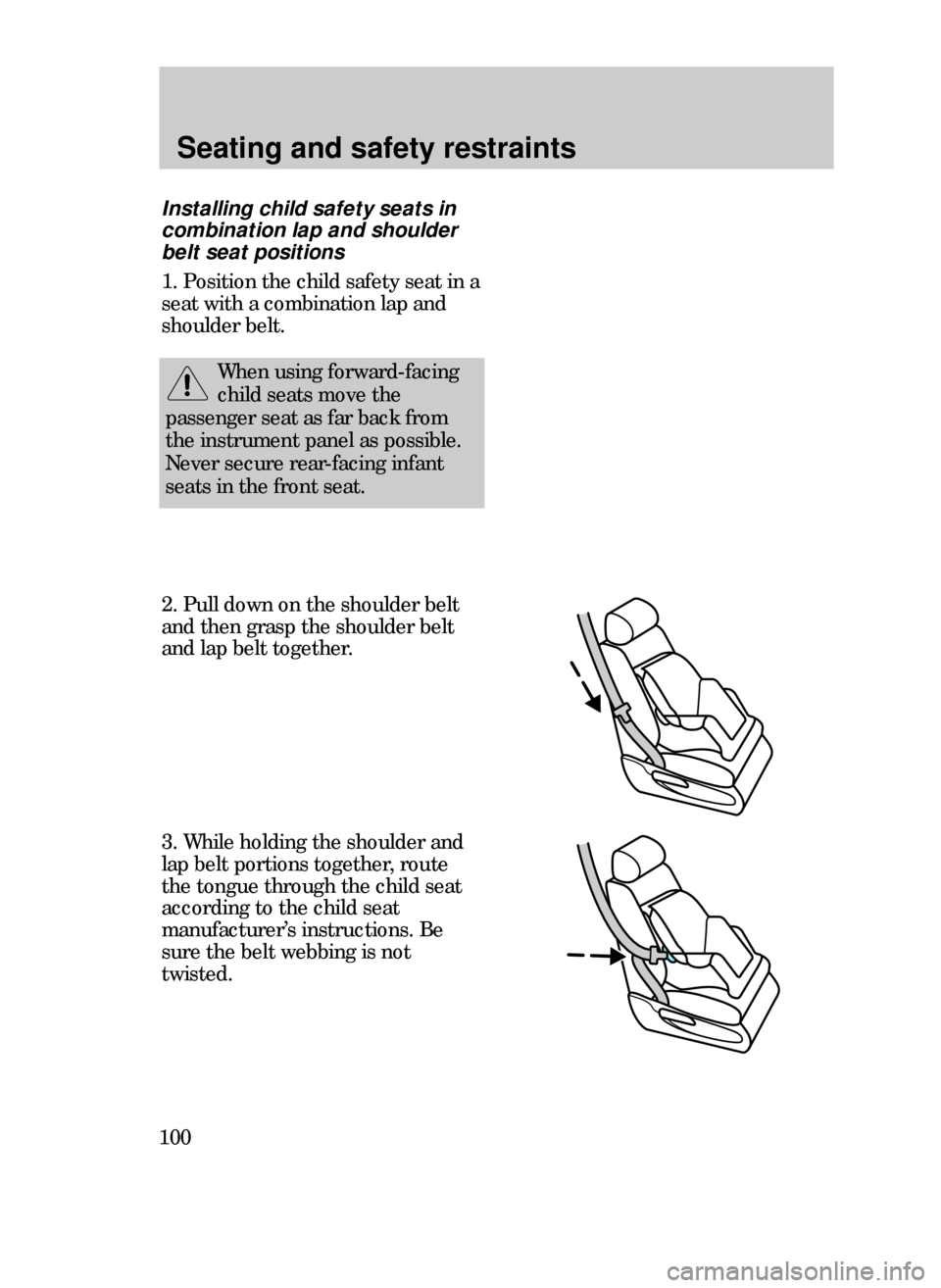
Seating and safety restraints
100
2. Pull down on the shoulder belt
and then grasp the shoulder belt
and lap belt together.
3. While holding the shoulder and
lap belt portions together, route
the tongue through the child seat
according to the child seat
manufacturerÕs instructions. Be
sure the belt webbing is not
twisted.
Installing child safety seats in
combination lap and shoulder
belt seat positions
1. Position the child safety seat in a
seat with a combination lap and
shoulder belt.
When using forward-facing
child seats move the
passenger seat as far back from
the instrument panel as possible.
Never secure rear-facing infant
seats in the front seat.
14CSSen 3/25/99 1:59 PM Page 100